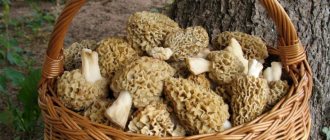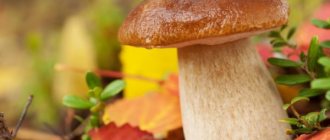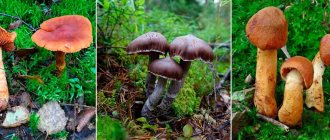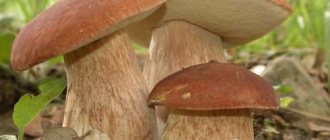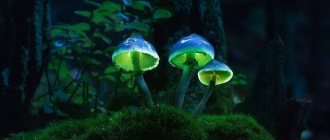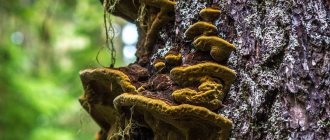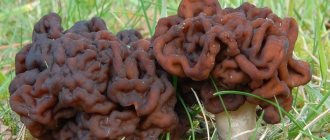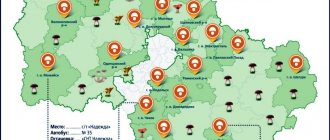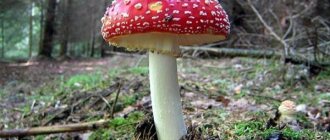How to avoid poisoning from edible mushrooms?
In many countries, mushrooms are not collected, but only purchased.
Those that have been tested by experts to ensure that they do not contain substances that can harm human health. In addition, some foreign insurance companies send free colorful booklets with photographs and information about poisonous mushrooms to their clients. It is better to have not one, but several mushroom identification books. Sometimes there is confusion associated with the names of mushrooms. Therefore, in many determinants and reference books (even very good ones) there is not enough “Latin”.
The whole country collects mushrooms from us. This is a mass activity in which a significant part of the country's population is involved. Unfortunately, mushrooms are not always collected in environmentally safe places. How often do we see people with baskets, bags or buckets looking for mushrooms in city parks, squares or along highways.
Poisoning from edible mushrooms occurs for a variety of reasons. “Contaminated” mushrooms, which contain high concentrations of heavy metals, pesticides, herbicides and radioactive substances, pose a great danger.
I was surprised by the story of one medical mushroom picker. It turns out that those mushrooms that are collected on the edges of forests near fertile agricultural fields are dangerous. Mushrooms, like sponges, collect all the “chemicals” that come from the field. This leads to poisoning and serious damage to the kidneys and liver. Scientists believe that “contaminated” mushrooms can cause the development of malignant tumors even with small doses of chemicals if they are supplied over a long period of time.
Overripe mushrooms are dangerous because their decay processes result in the formation of toxic substances of protein origin. It is better to leave such mushrooms in the forest.
You cannot collect those mushrooms that have mold, rotten and flabby places, etc. These are “sick mushrooms”. They are contaminated with pathogenic microorganisms. Mycotoxins are not killed either by heating at a temperature of about 200°C or by freezing.
The most dangerous poisonous mushrooms in the Moscow region and Moscow region
Most poisonous mushrooms belong to the category of lamellar mushrooms, so the main rule of the mushroom picker: if you find an agaric mushroom that is unknown to a person, it is better not to put it in the basket.
The most dangerous types of poisonous mushrooms found in this region are the following:
- The pallid grebe is deadly poisonous . Its main danger is that symptoms of poisoning appear after 8–10 hours (sometimes after two days), when toxic substances cause irreversible damage to internal organs, and it is no longer possible to save a person. Externally, the toadstool looks like a honey fungus.
- Fly agaric (red, green) is a poisonous mushroom that contains hallucinogens. Their caps are colored red or green with characteristic white dots. The legs are thick, hollow inside, cylindrical in shape. Fly agaric poisoning can be quite severe, even leading to hallucinations.
- The Satanic mushroom is the only poisonous representative belonging to the tubular category. The main symptom is the blueness of the flesh at the break.
Useful properties of mushrooms
The benefits of mushrooms have long been proven by scientists. They are a source of essential proteins that have a beneficial effect on the human body. Biologically valuable substances such as proteins, fats, carbohydrates, vitamins and microelements are well balanced, and the mushrooms themselves are low in calories.
When mushrooms are dried, their protein mass increases. Vitamins contained in mushrooms, such as A, D, E and PP, have a beneficial effect on blood vessels, the nervous system, skin, hair and nails, and can also remove bad cholesterol from the human blood.
They contain a high content of minerals, calcium, iron, B vitamins, which are responsible for the functioning of the nervous system, brain and skin. Lecithin, contained in the pulp of mushrooms, cleans cells and blood vessels, and riboflavin promotes the growth of nails and hair.
Truffles are the most expensive mushrooms in the world, obtained with the help of pigs and dogs.
They grow underground and have a special, unusual aroma, for which they are valued by gourmets.
Their price is approximately 5 - 7 dollars per gram. The cost of the most valuable black truffle is 500 thousand euros per kilogram.
Autumn honey fungus or True honey fungus Armillaria Mellea
Conventionally, an edible mushroom from the genus Honey fungus, family Physalacriaceae, is also known as Autumn Honey fungus. One of the most popular agaric mushrooms in Russia
Appearance
The cap is up to 10 cm in diameter, and occasionally up to 17 cm. In young specimens it is convex, then becomes flat, sometimes with wavy edges. The surface of the cap is covered with light sparse scales, which may disappear with age. The color of the cap is highly variable, it is assumed that it depends on the substrate on which the fruiting body grows. Those growing on poplar, white acacia, and mulberry have a honey-yellow shade of cap, on coniferous trees it is reddish-brown, on oak it is brown, and on elderberry it is gray.
The hymenophore is lamellar, the plates are attached to the stalk, or weakly running down it, sparse, in youth pale pink in color, later they become pinkish-brown, and may be covered with brown spots. Spore powder is white.
The leg is up to 10 cm long and up to 2 cm in diameter, yellow-brown in color, darker in the lower part. In the upper part there is a light membranous ring. The surface of the stalk is covered with flocculent scales; there is often a slight expansion at the bottom. In addition, the fruiting bodies are often fused with legs at the bottom.
The flesh in the cap is light and dense; in young specimens, it becomes thinner with age. The flesh in the stem is fibrous, becoming very coarse with age. It has a pleasant mushroom smell and taste.
Where and when does it grow
Autumn honey fungus is a parasitic fungus that lives on many types of plants - trees, shrubs and herbaceous plants. It usually bears fruit in large groups. It settles on weakened wood, causing white rot of the trunk. It can grow on already rotting wood, even fallen branches and cuttings of fallen leaves. Autumn honey fungus is famous for the fact that wood impregnated with its mycelium can glow in the dark with a faint white glow.
Armillaria Mellea is widespread throughout the Northern Hemisphere, except in the permafrost region. Prefers damp forests, slopes of ravines, places where deforestation took place.
It bears fruit from the end of August to the very beginning of winter, especially actively in the first half of September. Often appears in waves lasting 15–20 days.
Culinary use
Autumn honey fungus is extremely popular in Russia, in contrast to European countries, where it is almost never collected. It can cause eating disorders when consumed raw, so it is recommended to boil it first, although many lovers of this mushroom never do this. The pulp of this mushroom is tasty, but has a very dense structure and is difficult for the stomach to digest, so boiling it for 20 minutes will only benefit it. The mushroom is suitable for any type of culinary processing or storage for future use. The taste qualities of each individual specimen strongly depend on the place of growth, and on the age of the mushroom - as many variations of the area as there are variations of taste. In older specimens, the legs are too rigid and, as a rule, they are not collected. Common boletus Léccinum scábrum
Mushroom from the genus Leccinum, family Boletaceae. His names are also Obabok and Berezovik
Appearance
The cap is convex, initially hemispherical, then cushion-shaped, with a diameter of 6 to 15 cm. Its color can vary from light gray to dark brown depending on the growing conditions. The cap looks smooth, but in damp weather it becomes slightly slimy.
The tubular-looking plates, initially light, turn gray over time. Very easy to separate from the cap.
The leg is solid, cylindrical, up to 15 cm long and up to 3 cm in diameter. White-gray in color. The top is covered with a pattern of brownish scales, and the bottom has a slight widening.
The pulp is white when cut and does not change color after cutting. Very tasty and aromatic. The flesh of the leg is much tougher than that in the cap, but it is also quite edible and tasty.
Where and when does it grow
It bears fruit from early summer to early to mid-autumn, depending on the weather, in deciduous forests. As a rule, in the vicinity of birch trees, but not always necessarily. Sometimes it grows vigorously among young spruce forests, where there are only a couple of birches. Experienced mushroom pickers go for boletus mushrooms in mid-July, when they reach their peak form. Boletus is a very tasty mushroom, and not only people know about it. As a rule, autumn boletuses are already generously eaten by a diverse forest population.
It is found throughout Eurasia and the Americas. It even grows in the forest-tundra next to dwarf birches, and the local population calls them “overbirch trees” because there they are taller than the birches themselves.
When does mushroom picking begin?
The Moscow region covers an area of almost 45 thousand km², a significant part of which is occupied by forest plantations (up to 40%). Late spring and the beginning of the calendar summer is the time when it is time to get ready for a “quiet hunt”. The most mushroom places on the map of the Moscow region in 2022 are the Ruzsky, Kolomensky and Stupinsky districts, where you can pick up more than one basket of noble white or popular honey mushrooms.
| Name of mushrooms | May | June | July | August | Favorite places for mushrooms |
| Morels | 1-10 | Massive growth | No | No | Light deciduous forests - birch, aspen, oak, spruce, and cinder areas |
| Butter | 20-31 | 1-10 | Massive growth | Massive growth | Pine forests, edges and clearings of mixed coniferous-deciduous forests |
| Chanterelles | No | 10-20 | Massive growth | Massive growth | Mixed coniferous-deciduous forests, near pine, birch, oak. “Friends” with leaf litter, moss, and thick grass |
| Porcini | No | First decade | Massive growth | Massive growth | Well-warmed forests, with no dense thickets |
| boletus | No | First decade | Massive growth | Massive growth | Mixed forests with an admixture of birch |
| Boletus | No | First decade | Massive growth | Massive growth | Close to any deciduous trees |
| Mosswort | No | Last decade | Massive growth | Massive growth | Lowlands, moss cushions in coniferous and mixed forests |
| Summer honey fungus | No | 1-10 | Massive growth | Massive growth | Deciduous trees |
| Autumn honey fungus | No | No | No | 20-31 | Grows everywhere, both on living and decaying trees of mixed forests |
| Ryzhik | No | No | 20-31 | Massive growth | Conifers, especially young forest plantations |
| Real milk mushroom | No | No | 01-10 | Massive growth | Mixed forest, with a predominance of birch plantations |
| Volnushka (white, pink) | No | No | 01-10 | Massive growth | Old mixed forests, deciduous zone where birches are found |
On a note! Young mushrooms are best collected on the third day after summer rain. Lots of precipitation in July predicts a real mushroom invasion until the fall.
Where to go for mushrooms in the Moscow region
You can develop mushroom routes in advance, already in winter, so that in warm weather you don’t return from the forest with an empty basket. Each district of the region has its own protected areas, where, regardless of the weather, there will definitely be a harvest of mushrooms.
Ryazan direction
Not far from the railway platforms there are forested areas where you can try your “mushroom” luck:
- Lukhovitsy - to the north of the station there is a birch forest, rich in boletus and porcini mushrooms. At the edge of the forest, near a nearby lake, there are many boletuses;
- Shchurovo – near the village there is a coniferous forest, chanterelles and white chanterelles grow;
- Chernaya - in the pine forest not far from the station there are real plantations of boletus and chanterelles;
- Faustovo – at a distance of 3.5 km from the station;
- Bronnitsy - in the direction of the villages of Biserovo, Plaskinino (5-6 km).
Yaroslavl direction
Near the 43 km platform, deciduous forest plantations begin, from here you need to move along the bank of the Vyazi River towards the villages of Eldigino, Darino, Matyushino. The forest route stretches for 16 km, right up to Zelenogradskaya station. On both sides of the Semkhoz platform are the villages of Vysokovo, Morozovo (to the south of the railway) and Shapilovo (to the north). In an oak forest you are guaranteed to find noble mushrooms.
Kursk direction
Sharapova hunting platform - if you move north of the railway, then, before reaching the village of Pleshkino, you can “run into” a colony of honey mushrooms.
Kolkhoznaya station – boletuses and russula are found right next to the platform. And if you go a little further to the east or southeast, you can collect a full basket in a couple of hours.
Leningrad direction
The Pokrovka platform is famous for its abundance of mushrooms - on both sides of the station there are forests where chanterelles, boletus and porcini mushrooms grow freely. Frolovskaya platform - in the direction of the villages of Dulepovo, Marfino, Vvedenskoye (2-3 km on both sides of the station).
Paveletskaya direction
To the south of Moscow, the “assortment” of mushrooms is expanding; in protected areas you can pick boletuses and boletuses, honey mushrooms and porcini mushrooms:
- Belye Stolby or Barybino stations – move to the west (4 km);
- platforms Mikhnevo, Privalovo, Velyaminovo - in any direction, at a distance of no more than 3 km.
Riga direction
Lesodolgorukovo station - a forest rich in mushrooms begins to the north of the railway, on the way to the villages of Maryino and Nudol-Sharino. A favorite place for mushroom pickers, where full baskets can be collected in the most barren year, is on the banks of the Banka River, 2 km north of Opalikha station.
Belarusian direction
You need to look for boletuses, chanterelles, boletuses and boletuses near the Skorotovo and Khlyupino stations (to the north of the railway tracks). You can get off the train on any of the platforms - Petelino, Portnovskaya, Sushkinskaya, Chastsovskaya - and you will find a large forest with many different types of mushrooms.
Kiev direction
Bekasovo and Bashkino stations have a lot of forests; you can go in any direction from the platform and after 1-2 km you will come across whole families of boletus or russula. Most mushrooms grow in the territory of the Kuznetsovsky forestry, where you need to get from Ozhigovo station. The forests here are rich in mushrooms, but the length of the routes is about 150 km. To avoid getting lost, you need to take a navigator or compass with you.
Kazan direction
Near the 64 km platform there are mushroom forests. On one side - in the direction of the village of Kolomino (5-6 km), on the other - near the village of Turygino (5 km). If you get to Gzhel station, then after 4-5 km near the villages of Konyashino and Minino you can pick up a lot of porcini mushrooms. Near the Kuzyaevo station (former pioneer camp Podmoskovny) there are chanterelles, white chanterelles, and boletuses.
Savelovskoe direction
Real “deposits” of chanterelles can be found near the Taldom station, moving 3-4 km north of the railway. To put more noble mushrooms in your basket - porcini, boletus or boletus - you should get to the Morozki or Tourist stations and go to the villages of Paramonovo, Marfino, Dyachkovo. The richest mushroom places are near the village of Khoroshilovo.
White mushrooms
The dream of every mushroom picker and one of the most valuable trophies. It is quite common in central Russia, the main thing is to know the places.
The porcini mushroom (Boletus edulis) is easily identified by its rounded, slightly convex cap of a reddish-brown, dark orange, or yellowish hue. It reaches a diameter of 30 cm, covered with a matte velvety skin, darker in the center and lighter at the edges. After rain, the cap becomes shiny and a little slippery. The leg of the porcini mushroom is massive, in the shape of a club or a low barrel. It is usually lighter than the cap and covered with a network of greenish veins. When cut, the porcini mushroom is strong, dense, juicy, with white flesh and a faint pleasant aroma.
Where does it grow
Favorite habitats are old mixed forests with moderately moist soil. Prefers to grow under oaks, beeches, spruce and birch thickets, and hazel. It can often be found next to chanterelles and russula.
When to collect
The white mushroom appears in waves from July to October. The most abundant third wave begins in the second ten days of August and lasts until mid-September.
What can be confused with
Boletus edulis is similar to the white oak and white pine mushrooms (boletus), but they are edible look-alikes. It is much more dangerous to confuse it with the gall fungus (Tylopilus felleus) or the extremely toxic boletus mushroom (Boletus pulcherrimus). They can be distinguished from real porcini mushrooms by their cut: upon contact with air, the flesh of the first one gradually turns red, and the second one turns blue
In addition, if a small piece of the twin mushroom is carefully placed on the tongue, the bitterness will warn of danger. Real porcini mushroom does not taste bitter
At the end of this article, we will offer you useful mobile applications that will also help you visually distinguish edible mushrooms from inedible ones.
Edible mushrooms of the Moscow region
The soil and other accompanying natural conditions of the Moscow region (sufficient humidity, rainy season in the summer-autumn period, etc.) allow mushrooms to grow in countless numbers. Since there are, in principle, more edible ones than poisonous ones, they occupy a correspondingly larger area.
Porcini
Not a single mushroom place would be complete without porcini mushrooms. If you meet him somewhere, then you can assume that for the next 10 years it won’t be a problem to find him here. They are found under deciduous and coniferous trees, as well as in mixed forests. It is very difficult to say under which tree the probability of meeting him is greater, since he is not whimsical in this regard. But it is precisely by this criterion that porcini mushrooms can be divided into several categories:
- boletus - a small and plump mushroom, similar to fat men from cartoons - the already short leg is covered with a slightly tilted dark brown cap; such a strong man can only be found in coniferous forests;
- birch tree - from the nickname it is clear that it grows under birch trees, where there is enough light, which is why its cap is white-white;
- spruce - and this mushroom is different from its previous brother, it grows mainly in mixed coniferous-deciduous forests. Its brown cap with a reddish tint reveals itself relatively quickly, especially since it is easy to notice thanks to its high stem;
- oakwood - found more often in oak forests in late June and early July. The long leg barely holds the inconspicuous gray-beige hat.
More mushrooms of this species can be found on sandy or sandy loam soil.
Although porcini mushrooms are the kings of the forest among their own kind, there are still their doubles. They are called gall mushrooms. They differ in taste; the double has a bitter aftertaste. The good news is that gall mushrooms are not poisonous, at most they will cause diarrhea, but the experience is not the best.
Yellow breast
Photo: Holger Krisp / Wikimedia Commons
If you hear names such as yellow volukha, yellow podgruzd and scraper, then they also refer to this type of mushroom.
Outwardly, he is unremarkable. Its large cap is approximately 6-29 cm in diameter, and its entire surface is covered with small scales that are yellow. In principle, the skin of the cap is brown; golden skin is rare, but it still exists. Its edges form the top of the mushroom. If you touch them, they will be smooth and slimy, just like the cap itself. Over the years, it becomes more and more flat and concave; nothing remains of the hemispherical shape.
The strong stem matches the color of the cap, and you can feel the same to the touch. Almost noticeable dents on the stem are a distinctive feature of the yellow milk mushroom. It's hollow inside. The bottom of the fruiting body can reach 12 cm.
The pleasant aroma of the pulp attracts foresters in coniferous forests; it will be a godsend to encounter a scraper in birch groves.
These tasty mushrooms have doubles, but, fortunately, they secrete a lilac-colored milky juice, while the yellow mushroom on the cut is the same color as the name reflects.
Yellow milk mushrooms will not be old, but mature, from the second half of July.
Milk mushrooms have a bitter aftertaste, so it is better to boil the mushrooms at least 2 times, and then pickle or marinate.
Bluelegs
Photo: Strobilomyces / Wikimedia Commons
Bluelegs prefer to grow in colonies. At first it seems that this is a vision, since purple legs are visible under the yellowish caps of small diameter. If you cut a mushroom, the miracles do not end there: on the side of the cut you can find lilac-colored plates, which form the base of such an interesting color.
Another name for the bluefoot is the lilac-footed row. It does not tolerate growing in the shade of trees, as well as at their feet. It needs a large area to grow mycelium and the smallest number of competitors, so they are found on the edges of forests. Soil plays an important role. Bluefoot grows only on humus soil, which has an alkaline reaction.
This type of mushroom has a twin brother - russula. The mushroom initially described is distinguished by its strength, and during transportation it will be damaged much less than russula. The rowing season is autumn, it is not afraid of low temperatures and tolerates them calmly; in the summer you don’t have to look for it.
Since the blue leg is distinguished by its blue leg, some foresters avoid this mushroom. But in vain, it tastes pleasant and is comparable to black truffle.
Black truffle
This mushroom belongs to the category of marsupials. It differs in that it is the only one in its family that is completely edible and has no duplicates.
An experienced forester will say with 100% probability that black truffle is a delicacy and finding it is a great find for anyone. The shape of the mushroom is completely wrong, it looks like a fallen cone. The diameter of the find is approximately 3-9 cm. The lighter brown the mushroom you find, the younger it is. With age, it darkens and merges with the soil, turning into a coal-black mushroom.
Forest animals love to profit from them, so if you see red spots on the fruiting body, it means it has already been bitten on one side. It is rough and unpleasant to the touch, which cannot be said about the taste. The flesh is firm with an unusual marble pattern.
Any tree, in particular oaks and hazel trees, can be an indicator for its search, since it grows only at the foot. It smells fragrant, which is another reason why it is easily found by wild animals.
Common chanterelle
Photo: Strobilomyces / Wikimedia Commons
Chanterelles have a very interesting coloring, as well as the shape of the fruiting body. An orange and sometimes yellowish mushroom of irregular structure: the chanterelle changes its shape from flat to funnel-shaped. The diameter of the cap is about 6 cm. When you come into contact with the surface of the chanterelle, you will not feel anything nasty; it is smooth on the outside.
The stem is a continuation of the cap, even matching the previous part of the mushroom in color. The leg is small, less than 7 cm in height.
The flesh is elastic and pleasant. The sensory experiences here are inconsistent: the smell of chanterelles is reminiscent of a fruit smoothie, and they taste a little spicy. They are pleasing to the eye all 92 days of summer and almost all autumn.
Volnushka pink
The name speaks for itself. The unusual pink mushroom is relatively common. You can see almost all shades of purple on the cap. Such a colorful picture can be observed from 8 cm in diameter. Its edges are folded toward the stem to form the edge of the mushroom; it is also convex in this area, and in the center there is a slight deflection, like a child’s ping-pong ball. The flesh is light, without a hint of pink.
The older the mushroom, the more hollow its already short stem (4 cm) becomes. Most often it can be found in a birch grove from July to October, but it is also not uncommon among other trees.
Beneficial properties of autumn mushrooms
Mushrooms are very low in calories; they are sometimes recommended for cleansing the gastrointestinal tract and losing weight. But due to the difficulty of digesting their protein, you need to be extremely careful with mushrooms in case of cardiovascular pathologies and ulcers. Even with good health, you should not eat more than 150 g of them at a time, and they are completely contraindicated for children under 5-7.
Mushroom dishes can be stored in the refrigerator and reheated, but not for long and not many times. Very old mushrooms in any form, as well as salted or pickled ones, are dangerous when stored in galvanized, aluminum, or non-enameled iron containers.
Prevention of botulism, which has a 20% fatality rate:
- thorough cleaning and washing of mushrooms (vegetables, fruits);
- refusal to use low-quality mushrooms;
- compliance with the sterilization regime during canning;
- disposal of canned food with signs of swelling of the can;
- salting mushrooms in a non-sealed container.
Bacteria, without changing the taste of the product, are able to survive only in an environment without oxygen, releasing neurotoxins - one of the most powerful biological poisons. These poisons are resistant to high salt concentrations (up to 18%), are not destroyed in foods with spices, but do not withstand 30-minute boiling.
Name of early edible mushrooms with description
The very first to appear in the forests of the Moscow region are morels, champignons, raincoats and stitches. They appear in early spring and, one might say, open the “silent hunting” season.
Morels
These mushrooms lend themselves perfectly to any type of culinary processing. You should look for them in deciduous forests on nutritious soil. The growing period begins in April or the first week of May. Before using morels for culinary purposes, it is necessary to pre-clean them and cook them in salted or acidified water with vinegar.
Raincoats
These mushrooms live up to their name. You need to go looking for them immediately after the rain. In humid weather they grow literally before our eyes and in quite large quantities. Raincoats can be found in the second half of May. You should look for them near ravines, in clearings and meadows.
The shape of the mushroom cap is spherical. Upon closer examination, it can be noted that it seems to consist of several separate pieces. A distinctive feature of the raincoat is its huge size. Thus, the parameters of the fetus sometimes reach 35 cm.
Important!
In the CIS countries, raincoat belongs to the 4th category of mushrooms. This means that it must be consumed with extreme caution and only after careful cooking.
Stitches
The lines are considered conditionally edible. These fruits look similar to morels. They are quite fragile, ranging in height from 4 to 12 cm.
The color of the caps is chestnut, brown or yellow-brown. The shape of the cap part of the fruit can be called brain-folded. The pulp is light in color, but has neither a characteristic taste nor a distinct smell.
Champignon
Champignons are one of the most popular varieties of edible mushrooms. The most common species in the Moscow region is the common champignon.
The active growth season begins in April-May. Such fruits can be collected until late autumn, when the air temperature becomes stably low and the first persistent frosts occur. Champignon is one of those mushrooms that have a bright taste and a pronounced mushroom aroma.
Suitable months for quiet hunting
It is believed that one should go for mushrooms in the fall. This is due to the fact that at this time it rains more often, which means that delicious forest delicacies grow most actively.
In fact, experienced mushroom pickers begin stocking up already in the summer. If the weather is not hot, then good mushroom harvests are collected in July and August. Although in June, boletus and boletus mushrooms, which are nutritious and tasty, already begin to actively grow.
In September, after the start of the rainy season, almost all mushrooms begin to grow rapidly.
In October, the mushroom season begins to decline.
Therefore, to fill the basket, you have to go further into the forest and first of all pay attention to stumps and trees. Warmth and moisture remain there longer, and this is what mushrooms need for growth.
Moscow region
- If you move in the Leningrad direction , we recommend visiting the stations Firsanovka, Golovkovo, Podrezkovo, Berezki Dachnye, Frolovskoye.
- If you go from Kazansky station , get off at any of the following stations: Grigoryevo, Gzhel, Kuzyaevo, Ignatyevo, 73 km., Podosinki, Shevlyagino, Antsiferovo.
- If you head towards Yaroslavl , pay attention to the stations: Pravda, Pushkino, Zelenogradskaya, Sokolovskaya, Semkhoz, Sofrino, Kalistovo, Sharapovo.
- If you go in the Ryazan direction , feel free to get off at the stops: 63 km., Peski, Bronnitsy, Faustovo, Shurovo, Konevo.
When going for mushrooms by train, keep in mind that you will have to walk several kilometers to the nearest forests.
Collection of forest gifts
The autumn month is rich in forest gifts. What specimens can you find when you come to the forest?
Porcini
At the beginning of the month, boletus mushrooms are noticed, which live in spruce and pine forests. Moreover, porcini mushrooms grow longest in October in pine moss forests. Their development resumes after frosts pass, but the specimens freeze severely. Such a mushroom, diluted with water, is suitable for consumption. Boletuses are becoming increasingly rare in the fall, but they can actually be found in sunny meadows.
Butter
The late oiler, which has a membranous ring on the stem, also prolongs its growth. Externally, it is a mushroom with a 12-centimeter cap and a tubercle in the center, brown in color. It has dense yellow flesh, the skin peels off easily and sticks to your hands. The leg is medium, smooth to the touch, solid. The oiler's habitat is pine forests.
Black milk mushrooms
It is possible to find a black milk mushroom. It is found in mixed forests. The breast is dark greenish in color, with a hollow, small stem. He hides under withered leaves. When you find one, you can also find neighbors. If you salt it, it will have a great taste and a dense texture.
Umbrella mushrooms
Sometimes you can find a mushroom delicacy - this is a variegated umbrella. Of course, in October it is of a different variety and is presented as a blushing or shaggy umbrella.
Chanterelle
The mushroom grows until late frosts. Its color is like the yolk of an egg. The continuous stem flows smoothly into the hat. Young chanterelles have a convex cap, while more mature ones have a funnel with wavy borders on it.
Saffron milk caps
The saffron milk caps continue to grow in the fall. It doesn’t end even after frost. In summer and in the first month of autumn, the mushrooms are damaged by moss, but in October they are clean and have a dense structure. Habitat: pine and spruce forests.
Bitters
Pine and mixed forests in the fall are rich in the harvest of bitters, which do not die after the first frost. The mushroom has a red-brown color, a funnel-shaped cap with dry skin. Bitters produce white, bitter, acrid juice, so they need to be soaked for a long time, constantly changing the water. They are often salted.
Rows
Reddened row crowded is a little-known mushroom. The variety loves mixed forests and grows where there is a lot of sawdust. The row is found on pine stumps throughout the entire half of October. By the end of the month it disappears. These specimens always grow in a dense, large family. Harvest - about 100 pieces. The variety has smooth, dry skin. The hat is brown with a dark shade in the center. Small mushrooms with wide plates are white, mature mushrooms have a yellow tint.
There are also other varieties of rowing, which are very common after October 15th. Some of them tolerate cold well, so they can be collected until the end of the year.
If the frost hits lightly, the rows of gray and green species are not afraid of it, sticking out their caps from under the pine needles, the mossy area among the pines, from the sandy ground.
These are the same mushrooms that can be purchased on the market, only wild ones. Oyster mushrooms often have a very rich gray tint compared to self-grown specimens. They grow towards the end of October and are located on dead tree trunks.
greenfinch
This type of mushroom can be found throughout October. Their habitat is pine forests and beaches. Greenfinches are tasty, have pale yellow flesh, with green skin and a dark center. The leg is low, solid, yellow in color, almost always completely covered with sand. The greenfinch's hat is convex and has waves along the edge. After cooking, the green color of the mushroom remains.
Honey mushrooms
The productivity of honey mushrooms is in 1st place compared to other mushrooms. They are found near the most unpredictable places. More often these are fallen deciduous trees and stumps. Honey mushrooms grow thickly. They can even stick to an old stump.
Honey mushrooms
So, what mushrooms are picked in October? At this time, nature seems to freeze: silence reigns in the forest, which can only be broken by the rustling of yellowed leaves underfoot.
Do you want to know what mushrooms are picked in October? The first on the list should be, of course, honey mushrooms. Their share in the total harvest, as a rule, is a large part. In the forest they can be found in the most unexpected places, but most often on fallen deciduous trees and stumps. Moreover, they grow in fairly large clusters. Even an old stump in the garden can be a haven for honey mushrooms. Among mushroom pickers, they have firmly established the status of “cheeky” mushrooms. In mid-autumn, it is the autumn honey fungus that is most often found. What mushrooms are still picked in October? It should be noted that you can see large numbers of greenfinches and greenfinches that grow along forest paths and directly on sandy hills.
What mushrooms are collected in the Moscow region
The mushroom identification guide allows you to collect edible species in the Moscow region, as well as help you become familiar with the main, most common varieties.
Where mushrooms now grow in the Moscow region: map of mushroom places
Edible types of mushrooms in the Moscow region are very numerous, and the timing of their fruiting varies greatly depending on the soil and weather conditions in the collection area. The most popular and most mushroom-rich places among connoisseurs of “quiet” hunting include:
- forest mixed plantings around Zolotilovo in the Sergiev Posad region. It is in the north of the Moscow region that a large number of honey mushrooms, real chanterelles and white ones grow;
- forest plantings around Rumyantsevo in the Istrinsky district, where white, pigwort and nigella fruits abundantly, as well as honey mushrooms and moss mushrooms;
- forestry "Khlyupinskoye", as well as the villages of Uspenskoye, Skorotovo and Nazaryevo in the Odintsovo district, where an abundance of porcini mushrooms or honey mushrooms appear annually;
- forest plantings around Kolodkino in the Kolomensky district, where forests are rich in porcini and boletus mushrooms, boletus mushrooms, valuyas, volnushki, real and black milk mushrooms, white milk mushrooms, morels, russula, chanterelles, oyster mushrooms, summer and autumn honey mushrooms;
Where porcini mushrooms grow in the Moscow region (video)
- Beloomutskaya forest zone in the territory of the Lukhovitsky district, where from early spring until the onset of noticeable autumn cooling, varieties represented by boletus, silverback, greenfinches, honey mushrooms and boletus bear fruit;
- forest plantings around Ozeretskoye in the Dmitrovsky district, where you can annually harvest a very good harvest of boletuses, chanterelles and boletus;
- pl. Firsanovka, Solnechnogorsk district, where the first mushrooms appear in large quantities, and there is also abundant fruiting of boletus, porcini mushrooms, saffron milk caps and autumn mushrooms;
- forest plantings around Melikhovo in the Chekhov district are distinguished by an abundance of boletuses, boletus, honey mushrooms and aspen boletuses;
- forest plantings near the village of Aksakovo in the Mytishchi urban district, where early morels, boletuses and aspen mushrooms, as well as chanterelles and boletuses, begin to appear in the spring;
- the village of Vorgash, Taldomsky district, where porcini mushrooms, aspen and boletus mushrooms, honey mushrooms, various milk mushrooms and chanterelles fruit abundantly in the forests.
- The Yegoryevsky, Shatursky and Domodedovo districts, as well as the Prokudin Bor tract, the villages of Denkovo and Parfenki of the Istrinsky district, are very rich in mushrooms.
Delicious, healthy, free, yours
Photo: RIA Novosti/Alexey Malgavko
The wild berry season in the Moscow region has already begun and will last until late autumn. Moreover, amateur collectors will have something to do throughout this period. You can start today. It’s good that the Moscow region authorities published a whole map of where they can be found.
Strawberries
She ripens first. Strawberries grow in clearings and forest edges, on meadows and slopes covered with grass. And you can collect it until the end of July.
You can pick berries in the Serpukhov and Pushkin regions. Quite a few bushes grow near Bronnitsy and near Lake Biserovo near Noginsk. Traditionally, a lot of strawberries ripen in the clearings in the forests of the Shatursky and Yegoryevsky districts.
Raspberries, blueberries, blueberries
All these berries begin to ripen in July. They just hide in different places.
Raspberry bushes prefer to grow in forest clearings and clearings. Often, berry tourists find it in ravines or on the banks of forest rivers, in burnt areas and forest edges. It is best to go to the east of Lake Senezh for berries. It also makes sense to try your luck along the banks of the Dubna River and in the clearings in the Volokolamsk direction.
You can go to the forest to pick blueberries until September. The berry grows almost everywhere, but most of all it prefers swampy areas and spruce forests. Among all the districts of the Moscow region, the most blueberries are in the forests on the border of the Taldomsky and Dmitrovsky districts - in the floodplain of the Dubna River, in the forests of the Sergiev Posad district - closer to the border with the Vladimir region, in the forests of the Shchelkovsky district.
The berry can also be found in the Meshchera Lowland, in the forests of the Yegoryevsky, Shatursky, Orekhovo-Zuevsky and Lotoshinsky districts, in the forests of the Mozhaisk district, in the vicinity of the city of Vereya, Naro-Fominsk district and Ruza.
Map: welcome.mosreg.ru
Sweet blueberries will also ripen until September. There are only not many places where it can be found: mainly in the Taldomsky, Shatursky and Yegoryevsky districts.
Lingonberry, cranberry
These berries are the latest. Lingonberries begin to ripen around the end of August and grow mainly on sand and in pine forests along river terraces, on hills among swamps. In the Moscow region, it can be found in the coniferous forests of the Meshcherskaya lowland, Shatursky and Yegoryevsky districts.
Cranberry is the most autumnal berry. It makes sense to go looking for it no earlier than mid-September. But the fruits will ripen until the very end of October. But there are not many places where it can be collected: first of all, these are raised bogs. Most of these are in the Shatursky and Taldomsky districts.
Wild berries themselves are very healthy and have a huge supply of vitamins. What are the costs of just B1, B2, C and iron in one strawberry? In this case, it is worth paying attention to the leaves of the bushes. Many of them can come in handy on cold, virus-filled winter days. For example, raspberry leaves are used for colds and flu as an antipyretic and diaphoretic, and lingonberry leaves are generally considered a natural antiseptic and bactericidal agent.
By the way, picking berries in the Moscow region is allowed and is absolutely free. When going into the forest with a basket, you don’t have to worry that on the way back you will be asked to pay for the tasty treat or even given a fine.
September
Types of mushrooms: all varieties are preserved, but there are fewer boletus and boletus mushrooms. But you can see more and more honey mushrooms, moss mushrooms, and saffron milk caps.
Where to collect: Kievskoe and Yaroslavskoe highways are the main directions. If it starts to rain, you can return to the forest belts along the railway.
In the Moscow region 2022 in September there is an important property - if the weather is favorable, in the forests you can even find completely clean specimens, without a single worm. Good weather is a combination of rain and thaw.
If it rained for two days and then the sun came out, you can go mushroom picking every other day. Of course, there are already few chanterelles and boletuses, but again there are plenty of moss mushrooms and boletuses. At the beginning of the month there may still be a lot of saffron milk caps and milk mushrooms, the milk mushrooms begin to disappear, but in warm weather they can also be found.
In September you need to be careful because of the influx of hunters; drunken companies are often found in the forests. Naturally, it is better to look for the most distant places. September mushrooms are well salted and marinated; for some reason they turn out especially tasty. At the end of September there are a lot of mushrooms under the fallen leaves, from where they peek out. If the Indian summer is long, then collection can be carried out until mid-October.
Mushroom places of the Moscow region on the map in 2022
Experienced mushroom pickers will no longer be surprised by boletus, volushkas and various russulas. The time has come for noble mushrooms: porcini, boletus, and boletus. They can be found both in the vicinity of Moscow and in forests away from the metropolis. Lovers of quiet hunting boast with might and main of their collections online. We tell you where the best mushroom places in the Moscow region are located in 2022.
North
The top of the Moscow region is usually stingy when it comes to mushrooms. Usually, while southerners carry full baskets out of the forest, northerners are content with rare chanterelles.
- But this year there is an unusual trend. Most of the so-called noble mushrooms are in the north and east, says mycologist Mikhail Vishnevsky. — Records for whites happen in the Kalinin area. There are many of them in the territory from Solnechnogorsk to the border of the Tver region. They are well collected in the Sergiev Posad area.
With enough effort, mushrooms can be found in any part of the Moscow region. Photo: Evgenia GUSEVA
But there are also empty spaces. Here's what mushroom pickers are sharing on the Internet:
“Dmitrovsky district, Morozki: sadness. Boletus mushrooms - half to throw away, a drop of chanterelles, a couple of aspen boletuses.”
“I went to Lobnya. There are not enough mushrooms."
“In the Taldom region in two hours there are few chanterelles and a lot of russula.”
“Sergiev Posad district. Three buckets of whites in three hours!”
“There are a lot of mushrooms in the Fryanovo area, but all of them are chanterelles. There are no boletuses, boletuses, or boletuses.”
“I walked in front of Chernogolovka: 15 chanterelles. There is nothing beyond Chernogolovka. Mushroom-free."
“We were near Krasnoarmeysk over the weekend. There are no mushrooms yet: one white and one boletus.”
South
Traditionally the biggest catches are here. Among the record holders is the area of Domodedovo airport. There is also something to profit from in New Moscow, Tarusa, and Podolsk.
The southern regions are considered the most mushroom-producing. Photo: Svetlana MAKOVEEVA, “KP”-Samara”
“On Saturday, in 4 hours, 120 whites in Yusupov.”
“Domodedovo Airport: good russula - sea! Between the three of us, we collected more than 60 whites - all juicy and strong.”
“Stupino - in three hours 64 whites, a little aspen boletus and a bowl of chanterelles.”
“We collected a basket of whites in Tarusa! And most importantly, within a radius of three meters.”
“We recruited whites in Krasnaya Pakhra, New Moscow. Not on an industrial scale, of course, but enough for a good lunch and dinner.”
“Pervomayskoe. The noble ones have finally come - it’s impossible to resist.”
“Today Chekhovsky district - 73 whites, hurray!”
“Serpukhov region, attack of boletus. The young birch tree was generous with gifts.”
West
It is also considered rich in harvest. The most mushroom places: towards Serpukhov to the south and towards Zvenigorod to the west.
“We were in Nemerovo in the Ruza district. There are few mushrooms, the forest is dry! I'm waiting for the rains."
“Odintsovo district - just recently we came across only toadstools, but suddenly it’s flooded - boletus mushrooms almost jump into our hands!”
“The village of Uvarovka. It’s not enough, out of grief we salt the russula.”
“There is silence near Solnechnogorsk, except for russula and valuev, nothing, apparently, it’s still too early.”
“My mother and I went mushroom picking near the village of Artemka, Shakhovskoy district. Result: 70 whites each!”
East
Orekhovo-Zuyevo is full of chanterelles and russula. Mushroom places in Balakhna are not rich either, but in the Ramensky district of the Moscow region and Kolomna, judging by the reviews, there is something to profit from.
“We recruited white giants in Ramenskoye.”
“I’ve already gone to Balashikha 10 times - all the mushroom places are empty.”
“There is a sea in Kolomna! In an hour we collected a full basket of boletus and white boletus.”
“We have nothing in Noginsk except chanterelles.”
By the way
What's in the capital?
The most desperate fans manage to fill their baskets within Moscow. Some people advise going to the Mitinsky Forest, some swear that they saw whites in Troparevo, and some manage to gather something for dinner in Sokolniki. Experts do not advise doing this. Firstly, edible mushrooms almost don’t grow in the capital, more and more toadstools. And secondly, even among edible ones, not all are suitable for consumption. Still, the ecology is not the same.
Look when the mushroom season begins in Moscow and the Moscow region so you are sure to come home with a full basket.
Foresters' passion
More than berries, the forests of the region are famous only for their mushrooms. And such a rainy spring promises a fertile season for all professional collectors. For their convenience, the Moscow Region Tourism Committee also compiled a map, only now it’s a mushroom map.
Morels, boletus, boletus and chanterelles
You can go in search of “hats”, as well as for berries, now. Morels were the first to please mushroom pickers. They began to appear in forests at the end of April, growing mainly in old fires, clearings warmed by the sun, and on the slopes of ravines.
Note to lovers: the cap of these mushrooms looks like an elongated brown cap with folds and is the most delicious part.
Boletus mushrooms appear next. You can go for them as early as May. These mushrooms prefer deciduous and mixed forests - those where, naturally, birch trees grow most of all.
June is the time for boletus and chanterelles. The latter should be looked for in the grass or rotted leaves of mixed forests - they do not like conifers. But boletus prefer sunny clearings with low trees in coniferous forests with sandy soil. By the way, several types of them grow in the Moscow region, so the mushroom caps can be brown or reddish.
Map: welcome.mosreg.ru
The earliest, the latest and the most loved
The most popular among local mushroom pickers are, of course, oyster mushrooms. There is only one reason: you can look for them in regional forests almost all year round. They grow mainly on deciduous trees, most often on aspen and birch, but the mushroom can also be found on coniferous trees. In order not to be mistaken: the color of the oyster mushroom cap can be different - from dark gray in young mushrooms to ashy with a purple tint in mature ones.
And finally, the most valuable one is the porcini mushroom. He appears in the forests later than everyone else - only in July. It is best to go for it to where there are a lot of oaks and birches. Basically, of course, these are mixed forests.
Well, the answer to the main question: where to go with wicker baskets. The most “mushroom” places in the Moscow region are Chekhov, Serpukhov, Yegoryevsk, Domodedovo, Volokolamsk, Kolomensky, Mozhaisky and Ramensky urban districts.



